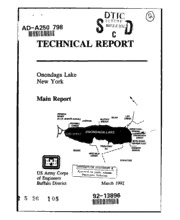
DTIC ADA250798: Technical Report, Onondaga Lake, New York, Main Report PDF
Preview DTIC ADA250798: Technical Report, Onondaga Lake, New York, Main Report
AD-A250 798 MY2 1992 TECHNICAL REPORT Onondaga Lake New York Main Report SRIEVNEERC AE LEY( (NVY $. BARGE CANAL) LIEPO LOODY SAUINA CE SAWMILL UVEO A ROO US BARGE CANAL ONONDAGA CREEK oEnie SEWAGE WEATMENT PLANT TRIBUTARY | HRO GEDDES 00 .,.-" BROOK NINE MIE .0" ~CREEK \\ SYRACUSE US rmyCors Aprc-dfor Publlc r~lease; ] of Engineers Buffalo District March 1992 92-13896 5 2105 55 1 I[l/!!l!U/llU~lili!